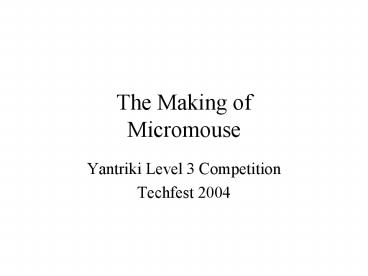The Making of Micromouse - PowerPoint PPT Presentation
1 / 18
Title:
The Making of Micromouse
Description:
The Making of. Micromouse. Yantriki Level 3 Competition. Techfest 2004. The Problem ... Track width 0.3 mm minimum. Distance between two tracks 0.4 mm minimum ... – PowerPoint PPT presentation
Number of Views:168
Avg rating:3.0/5.0
Title: The Making of Micromouse
1
The Making of Micromouse
- Yantriki Level 3 Competition
- Techfest 2004
2
The Problem
3
The Team
- Nirav Salot - IT (nirav_at_it.iitb.ac.in)
- Praful Hebbar IT (praful_at_it.iitb.ac.in)
- Vinay Savla EE (vinays_at_ee.iitb.ac.in)
4
Components
- Microcontroller
- Motor
- Sensors
- PCB
- Battery
- Chassis
- Software
5
Microcontroller
- ATMEL 89C52
- Cheap easy to use
- 8KB of EEPROM and 256B of internal RAM
- 64KB of external RAM
- Configuration
- Port 0 and Port 2 to interface external RAM of
32K - Port 1 to drive both motors (4 coils each)
- Port 3 for sensor control
6
Motor
- Choices
- DC Motor
- High torque
- Low Power Consumption
- Smaller size and lighter
- Cheaper
- Complex speed control
- Difficult to achieve accurate movement
- Stepper Motor
- High holding torque
- High Power Consumption
- Bulky
- Costlier
- Easy to achieve accurate movement
7
Problem with Stepper Motor
- Limited choice available in market
- Data sheet and specification not easily available
- Difficult to judge suitability for micromouse
8
Sensors
- Choices
- Ultrasonic
- InfraRed
- Mechanical Sensor
- InfraRed
- Need for modulation
- TSOP IR Receiver and filter package
9
Sensing Strategies
- Sideways and front looking distance measurement
- Sideways and front looking wall presence
measurement - Down looking wings sensors
- Combination of above
- Our Choice
- Sideways and front looking wall presence
measurement - Placement and no of sensors
10
Sensor and Motor
11
Battery
- Choices
- Alkaline
- NiMH Nickel Metal Hydride
- NiCd Nickel Cadmium
- Lead Acid
- Our Choice
- Our requirement 12 V / 1.5 Amp
- Lead Acid (12V / 1.6 AmpH)
12
PCB
- Eagle software for design
- Points to consider
- VCC and GND tracks should be thicker
- Track width 0.3 mm minimum
- Distance between two tracks 0.4 mm minimum
- PCB manufacturing takes 3-4 days at least
13
PCB
14
Chassis
- Wheel Design
- 4/3/2 Wheels
- Our Choice
- 2 wheels with castor
- Easy to achieve accurate turns
- Easy to design and make
- Ball castor
- Points to consider
- Center of gravity as low as possible.
- Moment of inertia as small as possible
- Balance of weight on wheels and castor
- Light and Compact
15
Chassis
16
Chassis
17
Software
- Written in C, compiled using Keil
- Simple BFS algorithm (see simulator)
- Features
- Guaranteed to reach the destination
- Will eventually find the shortest route
- Maintains limited history
- Avoids jerky motion during exploration
- Correction Strategy
- Both side walls present
- One side wall present
- Wall edge detected
18
Thank You.
- For more information check
- www.it.iitb.ac.in/nirav/umouse































